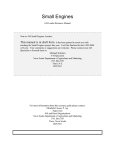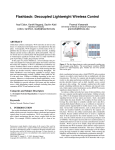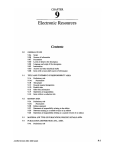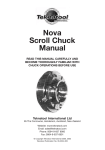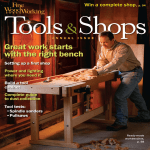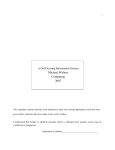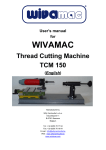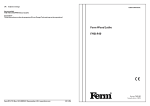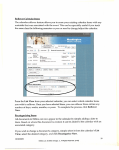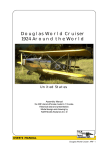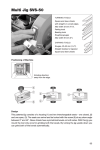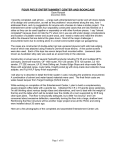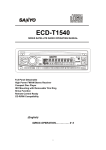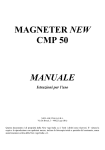Download 4-H Woodworking Leader Guide
Transcript
Provincial 4-H Office 4-H and Rural Organizations Nova Scotia Department of Agriculture and Fisheries P.O. Box 550 Truro, Nova Scotia B2N 5E3 Phone: (902) 893-6585 Web site: http://www.gov.ns.ca/nsaf/4h 4-H MOTTO “Learn to do by Doing” 4-H PLEDGE I pledge my head to clearer thinking, my heart to greater loyalty, my hands to larger service, and my health to better living. For my club, my community and my country. 4-H Specialists to Contact If you have any questions, contact the 4-H Specialist in your area: Western Region - Yarmouth, Digby, Annapolis 584-2081 South Shore Region - Lunenburg, Queens, Shelburne 543-0616 Valley Region - Hants, Kings 679-6027 Central Region - Halifax, Cumberland, Colchester 893-6586 Eastern Region - Antigonish, Guysborough, Pictou 863-4705/ 485-7161 Cape Breton Region - Richmond, Cape Breton, Inverness, Victoria 563-2000/ 945-2901 Table of Contents The Woodworking Project Year . . . . . . . . . . . . . . . . . . . . . . . . . . . . . . . . . . . . . Section 1 C C C C Achievement day Teaching the Project Important Steps in Teaching Project meetings General Information and Basic shop Safety . . . . . . . . . . . . . . . . . . . . . . . . . . . . Section 2 About Wood . . . . . . . . . . . . . . . . . . . . . . . . . . . . . . . . . . . . . . . . . . . . . . . . . . . . . Section 3 C Importance C Hardwood and Softwood C Grain C Selecting Wood C Identification Woodworking Plans . . . . . . . . . . . . . . . . . . . . . . . . . . . . . . . . . . . . . . . . . . . . . . . . Section 4 C Transfer a pattern C Enlarge a pattern Measuring and Cutting . . . . . . . . . . . . . . . . . . . . . . . . . . . . . . . . . . . . . . . . . . . . . Section 5 Shaping . . . . . . . . . . . . . . . . . . . . . . . . . . . . . . . . . . . . . . . . . . . . . . . . . . . . . . . . . Section 6 C Rasps and files C Wood chisels C Planes C Carving C Sharpening Hammer and Nails . . . . . . . . . . . . . . . . . . . . . . . . . . . . . . . . . . . . . . . . . . . . . . . . Section 7 C Know Your Nails C Choose the Right Nail C Starting Nails C Driving Nails C Nail set C Pulling Nails Drills and Screws . . . . . . . . . . . . . . . . . . . . . . . . . . . . . . . . . . . . . . . . . . . . . . . . . . Section 8 C Drilling Holes C Common Drill Bits C Screws C Screwdrivers C Choose the Right Screw C Installing the Screw Glueing . . . . . . . . . . . . . . . . . . . . . . . . . . . . . . . . . . . . . . . . . . . . . . . . . . . . . . . . . Section 9 C Glues for Indoors C Glues for Outdoors Sanding and finsh . . . . . . . . . . . . . . . . . . . . . . . . . . . . . . . . . . . . . . . . . . . . . . . . Section 10 C Hiding the Holes C Stains C Wood Sealers and Fillers C Penetrating Finishes C Surface Finishes C Paint brushes Joints . . . . . . . . . . . . . . . . . . . . . . . . . . . . . . . . . . . . . . . . . . . . . . . . . . . . . . . . . . Section 11 C Edge Joint C Butt Joint C Dowel Joint C Rabbet Joint C Dado Joint C Mortise and Tenon Joints C Dove Tail Joints C Lap Joint C Miter Joint Lathe Work . . . . . . . . . . . . . . . . . . . . . . . . . . . . . . . . . . . . . . . . . . . . . . . . . . . . Section 12 Where to Get More Help and Acknowledgments . . . . . . . . . . . . . . . . . . . . . . . Section 13 THE WOODWORKING PROJECT YEAR Dear 4-H Leader: Welcome to the world of woodworking. If this is your first year you must be eager to learn as much about the 4-H program as you can. This project is designed to be fun and meaningful while you learn the art of woodworking. Woodworking skills can be put to use around the home, in the shop and to make gifts for others. Achievement Day Achievement day allows members to display to the public, the projects they have worked on all year and have them evaluated non-competitively. Project completion at Achievement Day requires a satisfactory completion of a number of requirements. Please refer to the Woodworking Project Newsletter of the current 4-H year for detailed information on project requirements. There are many topics to cover in the 4-H Woodworking Project. 4-H members of all ages will find something to interest them. As a leader, seeing what the members already know will be important. Briefly review the material they know and then move onto new and interesting topics. Teaching the Project Most of us would agree that the core of 4-H club work is the project. Traditionally, club work has been organized so that every member takes a specific project. Through the project, club leaders work with members to help them achieve the objectives of 4-H. A member who successfully completes a project will receive: • • • • • A feeling of accomplishment; A challenge to his or her abilities; Attention from others, mainly through displaying a project at Achievement Day; Pride of ownership; Sense of responsibility. The job of the project leader is important. Effective project leadership really begins with the wise selection of projects. As a Woodworking Project leader help your members choose a plans to suit their interests and abilities. The Woodworking Project Year Section 1- 1 Important Steps in Teaching Draw up a plan for the year - Planning should be done near the beginning of the club year. Decide how many meetings your project group will hold and what topics are to be studied. In planning, decide what will be taught, how and by whom at each meeting. You may want your members to help, particularly older members, and each member in your project group should have a copy of the plan. Consider your members - Before starting to teach, it is wise to look at the number of members, their ages and their experience. Try to keep the size of your project group to no more than eight. This will depend on your member’s interest in the project. If you have more than this number divide the group based on their age and/or experience level or find more project leaders or assistants. You could draw on the experience of the oldest members to help with the younger members. C C C C < A good incentive is praise for work well done, rewards strengthen and maintain any learning that leads to them. Too much or undeserved praise has a bad effect; Praise is better than criticism and constructive criticism is better than completely ignoring a learner's efforts; Sarcasm and ridicule affect self-esteem. To like and respect the teacher helps the learning process. Gain the interest of the members - To obtain and keep the members’ interest you must become aware of the importance and interest of the topics presented to them. Present a positive experience for the members. This is easier with some parts of the project than others since some phases are easier to relate to the members. For example, members may be more interested in working with their initial construction, but it may be a challenge for the project leader to show members the importance of keeping records. Types of motivation for members : < Competition - competition may act as a motivation to learn for those who feel they have a chance to win the competition, but do not let it get out of hand so that the individual's personal development may suffer. < Cooperation among members and opportunities for advancement are motives that affect learning. Start where the members are - At the start of the year find out what it is about the project that interests them, how much they already know and if they have any questions. This will help you know where to start teaching and the interest of your members. As you teach, make sure the topic being discussed, the words, charts and other teaching tools being used can be understood by all members. Have every member active - Involve as many members as possible through planning, arrangements for the meetings and at the meeting itself. Wherever possible, a practice session should follow project instruction, giving every member a chance to become involved. Experience is the best teacher and members retain more information if they learn through practical experience. The Woodworking Project Year Section 1- 2 It has been shown that we remember: < < < 30 percent of what we hear; 80 percent of what we see and hear; 90 percent of what we actively participate in. Making teaching practical - Wherever possible, use real items in a demonstration rather than pictures. For example, in teaching how to sand, use a real piece of wood and sandpaper rather than just talking or only using posters. Use a variety of teaching methods - When doing your planning for the year, consider different ways of presenting the material and choose the method that will be the most suitable. Each method will have advantages in particular situations and a change in teaching methods helps to maintain interest. Remember younger members need more frequent changes and more activity to deepen their interest so plan activities that last no more than 20 minutes. Members in their early and mid-teens like to work in groups, which means you can use panels, role-playing, and other group techniques. 4-H members enjoy tours, guest speakers, demonstrations, quizzes and hands on activities. For specific activity project ideas please refer to the end of the unit. Project Meetings Wherever you hold your project meetings, be sure your members are comfortable and don’t have other distractions. Project Meeting - The project meeting may follow a general meeting or it may be held at a different time. Following are suggestions to organize the project meeting: C Project Reports by Members - This might be the first item in the meeting. It provides an opportunity for members to report on their project work since the last meeting, to bring up any problems or questions and for you to determine their progress, answer questions and make suggestions. C Introduction to the Next Topic - Outline the new topic and the reason for its importance. This is the place to gain the members’ interest so that they will be attentive for the next part. C Group Instruction - This is where the actual teaching of the new topic takes place using the best method. This may be done by you, the members or by a special resource person. C Group Activity - This is a practice period in which the members do something. If possible, they should practice what has been taught. If not, they may work on record books or practice demonstrations. C Individual Help - While the group activity is going on, you may help members who need closer attention or extra help. C Preparing for the Next Meeting - This is the time when you give instruction on homework to be done, items to bring to the next meeting or last minute reminders. The Woodworking Project Year Section 1- 3 GENERAL INFORMATION FOR THE WOODWORKING PROJECT LEADER WOODWORKING COMPETITION at NS 4-H Provincial Show Class 66: 1. Open to top junior and top senior woodworking member from each county. 2. Junior members must bring sandpaper, block, brush, rags, and a hammer. 3. Senior members must bring all of the above and a Red Robertson Screwdriver. 4. All other materials will be supplied by the organizing county. 5. Requested to construct a small useful item, sanding and staining to finish in a set time period to be announced at the beginning. 6. Members will be judged on construction techniques, sanding and quality of the finished product. 7. Prizes will be presented to the top junior and top senior members in this competition. SUGGESTED WOODWORKING 4-H MEMBER SKILLS LIST It is important to keep in mind the equipment and facilities you have. Everyone will become frustrated if you attempt a project that is beyond the range of your shop. This list of suggested skills is a guideline only, and needs to be tailored to your group. It assumes a member is 9 in year 1. If they are older, the skill development will probably happen faster. There are other skills not covered in this manual, that members may need to finish a project, and for these, a good woodworking reference may be needed. In their senior 4-H years, members should be refining their skills, doing larger more complicated projects, experimenting with different finishes and helping younger members. When members should begin using power tools is a decision that must be made with the leader, member and parent. Year 1 could learn about shop safety, the importance of wood, measuring & cutting wood (square), nailing, butt joints, gluing, sanding, finishing, proper tool use. Suggested projects include cutting boards, puzzles, letter holders, key holders, peg board, simple 2-3 piece shelves. Year 2 could review first year skills and shop safety, plus drilling, butt, joints, edge joints, angle cuts (miter joints), screws (predrilling & counter sinking), types of wood and wood selection. Appropriate projects could include bird houses, book ends, picture frames, shelving, corner shelves, simple stools, clocks. Year 3 members would review year 1 and 2 material, shop safety, jointing & gluing boards together, rabbet and dado joints, dowel or biscuit joints, sharpening tools and identifying wood. Possible projects might be tables, large tool chest, book shelves, foot stools, deacon benches. Year 4 members could review year 1 to 3 material, shop safety, mortises & tenon joints, through tenon joints with wedges, lathe work, single spindle projects. Projects could be stools, chairs, colonial bench, coat tree, what not shelf. Year 5 members would review Year 1 to 4 material, shop safety, dove tail joints, lap joints & other joinery techniques, lathe work bowls (face plate work), carving. Suggested projects include bedside table, foot stool, garden seat, plant stands, salad bowls. The Woodworking General info and Basic Project Shop Year Safety Section 21- 4 BASIC SHOP SAFETY Learning and Doing: < < < to learn the basics of shop safety to learn where information about safety can be obtained remind older members about the basics of safety Possible Activities: < < < have members read the operators manuals for the tools they will be using have members generate a “Shop Safety List”, using the Resource Information section, and post it in the work area. Have younger members start the list, and older ones finish it. remind members about the importance of safety on a regular basis Suggestions for Meeting Preparation: < < < locate the operators manuals for the tools the members will be using have a Bristol Board and markers available to make the Shop Safety List make sure a well stocked first aid kit is available Resource Information: The best ways to ensure safety are to use good common sense, and to be informed about possible hazards. This list has some safety rules to keep in mind, but there are many more! SOME WOODWORKING SAFETY RULES TO ALWAYS KEEP IN MIND: -Save lively activities for the outdoors- a shop is not the place to throw things or run around. -Always use safety glasses for eye protection, and dust masks when sanding. -Dress appropriately. This means sturdy footwear, long pants, and roll up or tuck in loose fitting clothing. -Tie back long hair, remove dangling jewellery. -Do not operate any tools until you have been shown how. -Make sure all the guards are in place for power tools. -Always review and follow the tool manufacturer's safety recommendations. -Look after tools, sharpening, lubricating and replacing when necessary. Make sure the cords are in good condition, and the electric tools have a three prong grounding plug. -Be careful when handling sharp tools, so you don’t accidentally hurt yourself or someone else. -Unplug and put away the tools when you have finished using them, so no one will cut themselves, or trip over them. -If it feels a little dangerous, it probably is. Find another safer way to accomplish this task. -Always keep your hands well clear of the action, use both hands to hold tools if you are younger, and use push sticks. -Use leg muscles when lifting heavy objects, not back muscles. -Keep the work area well lighted and ventilated. -Follow the manufacturer’s directions regarding precautions, disposal and ventilation when working with solvents, paint or glue. -Wear gloves when working with paints and varnishes to avoid skin contact. -Be alert! Do not work if you are too tired, since this can increase risk of accidents. -Take care of accidents promptly. Have a well stocked first aid kit in the shop. The Woodworking General info and Basic Project Shop Year Safety Section 21- 5 ABOUT WOOD Learning and Doing: < < < < the importance of wood the types of wood how to select wood for the project identifying wood Possible Activities: < < < < write and circle “The Importance of Wood” in the middle of a large piece of paper. Have members write their ideas on sticky notes, and arrange them outside the circle. See Resource Information section for possible ideas. visit a lumber yard or a lumber supply store to see the different types of wood, and learn to identify the common ones. have a discussion about how to select wood. Have some examples to show members look at hardwood and softwood with a magnifying glass Suggestions for Meeting Preparation: < < < < < T obtain some bristol board, chart paper or other large paper, a package of sticky notes, and markers make arrangements with a lumber yard or lumber supply store for a tour/session find some examples of good and bad choices in wood selection obtain a magnifying glass, and samples of hardwood and softwood locate a reference to help with identification of wood, such as: Feirer, John L., Wood, Technology and Processes, Glencoe/McGraw-Hill, 1994 Resource Information: Importance Wood has always been important to our society. It provides warmth and is used for shelter. Wood is used for buildings other than homes, such as barns and garages. Furniture, cupboards and many other everyday items can be made from wood. Wood is processed into paper, and all sorts of related paper products. It is even used in the manufacture of fabrics and plastics. Employment is provided for people from tree planters, thinners, and harvesters to truck drivers, mill workers, and ultimately even store clerks. Hardwood and softwood The two main types of wood are hardwoods and softwoods. Hardwood trees are broadleaf deciduous trees such as maple, oak, birch and cherry, which loose their leaves in the winter. The wood is usually heavier, stronger and harder, and is more suited to furniture, paneling, flooring and cabinets. Softwood trees are coniferous with needle-like leaves, such as spruce, pines, firs and cedars, which stay green all winter. Softwood is used for poles, regular lumber purposes in construction, plywood, and can be used for some of the same purposes as hardwood. In general, softwood is easier to work, more resistant to rot, strong enough for general purposes and relatively inexpensive. About Wood Section 3- 1 Grain As they grow, trees form an annual ring each year. These annual rings give the faces and sides of wood it’s unique patterns, which are called grain. Depending on where the sawmill makes the cut, the grain can look quite different. The diagram illustrates where flat grain and edge grain lumber would be found in a log. Branches also grow on trees, and these create changes in the direction of the grain of the wood. This can create a desirable attractive appearance, or it may detract from the appearance. Knots usually reduce the strength of the wood, and if the branch has been dead for a while, the knot may fall out, leaving a hole. Selecting wood When selecting lumber for your projects, there are lots of things to remember. If the wood is “rough”, it will be just as it was cut at the sawmill. If it is “dressed”, the actual dimensions will be less than the size indicated, because the rough wood has been put through a planer. Wood will also be larger or smaller depending on how dry it is. Furniture and other fine projects are the only ones needing kiln dried wood, otherwise use air dried. Select the grade of wood suited to your project. If you will be applying a natural finish, it will need to be a better grade than if you will be painting the project. Some things to look out for include: C wood that is clear, if there are any knots, they should be in a place where they won’t give you problems C look out for checks, cracks or splits in the wood C is the wood sound, not rotten C is the board warped in any way. Sight down the edges of the board. C is the wood stained, or clean Identification To be able to identify wood takes lots of experience and practice A magnifying glass can help, since hardwoods have large open cells, called “pores” at the start of each annual ring. All hardwood has pores, but he pattern and number of pores will vary, providing a valuable identification tool. Softwoods do not have pores, but have a few scattered openings called “resin canals”. In softwood, the cells are lined up in a very uniform pattern, from the center of the tree, to the bark. In hardwood, the cells are not lined up in straight rows. Identification will have to be done using pictures in a book, a resource person or internet research. About Wood Section 3- 2 WOODWORKING PLANS Learning and Doing: < < < how to transfer patterns enlarging a pattern working with plans Possible Activities: < < < help members trace their pattern onto their wood have members enlarge a pattern for practice have members sketch their plans so they will be more familiar with the project, and will be able to visualize it better Suggestions for Meeting Preparation: < < < < T T T T T T T T T T T T T T T T have wood and patterns available for members to use ask members to bring pencils and paper have some plans available for members to look at check out some other sources of plans, like the internet, woodworking magazines or books. Reference material available from the library could include: Better homes and gardens woodworking projects you can build / [editors, Noel Seney, Larry Clayton]. Des Moines, Iowa : Meredith Corp., c1980. Blanford, Percy W., 77 One-weekend Woodworking Projects, Tab Books Inc., 1987 Feirer, John Louis. Advanced woodwork and furniture making / John L. Feirer and Gilbert R. Hutchings. Peoria, Ill. : C. A. Bennett Co., c1978. Fine Woodworking on things to make : 35 articles / selected by the editors of Fine woodworking magazine. Newtown, Conn. : Taunton Press, 1986. Jacobson, James A. More projects from pine : 33 new plans for the beginning woodworker / James A. Jacobson. Blue Ridge Summit, PA : Tab Books, c1988. Lasson, Robert, 1922- If I had a hammer: woodworking with seven basic tools. Photos. by Jeff Murphy. New York : Dutton, [1974] Nelson, John A., 1935- The weekend woodworker : 101 easy-to-build projects / by John A. Nelson. Emmaus, Pa. : Rodale Press, c1990 Parkinson, Ralph F., Wooden Toys and Games, Chilton Book Company, 1984. Popular science woodworking projects ... yearbook. New York : Popular Science Books, 1985Self, Charles R. 101 quick & easy woodworking projects / Charles R. Self. New York : Sterling Pub. Co., 1992 The weekend woodworker : 40 easy-to-build projects : shelves and cabinets, toys, tables and chairs, boxes and mirrors / selected by the editors of Rodale Books ; edited by Rob Yoder. Emmaus, Pa. : Rodale, c1991. Woodworking projects I to IV : --- easy-to-make projects from hands on magazine. Dayton, OH : Shopsmith ; Emmaus, PA : Rodale Press, 1985 - 1988. Video - Small shop projects : boxes / with Jim Cummins. Newtown, Conn. : Taunton Press, c1990. Video - Chairmaking techniques/ with Jeff Miller. Newtown, Conn. : Taunton Press, c1997. Video - Rogers, Avian Building tables. Charlotte, N.C. : Do-It-Yourself Video Corp., c1985. Magazine - Better Homes and Gardens Wood. Woodworking Plans Section 4- 3 Resource Information: From building plans and drawings you must be able to determine the measurements needed to cut, drill and fit. You will also need to know what material is needed to begin the project, if it is not listed in the plan. In a perspective drawing the object looks like it would in a photograph. Object lines outline the object and are the thickest. Extension lines extend from important corners or from the centres of holes to slightly beyond the dimension lines. Dimension lines are narrower and have arrows to show where measurements start and stop. These lines are not part of the object but give the length, width and thickness of pieces and positions of holes. Plans all differ slightly, but provide the information to enable you to build a project. Transfer a pattern Sometimes a project includes a shape that is not square or rectangular. You usually transfer a curving shape onto the wood by tracing the pattern with carbon paper. Check that lines are dark enough to see while sawing, and that lines are connected before removing pattern and carbon. You can also trace the pattern onto heavy paper and cut it out, then place the heavy paper version on the wood and mark the outline with a pencil. Do not damage books and patterns by using a sharp pencil. Use tracing paper or photocopy the pattern if necessary. Enlarging a pattern Patterns of irregular shapes may be too small to trace. If the size you want is larger than a photocopier or computer can produce, you can use a grid. First, draw a grid on the original article. Number and letter each line as shown. Decide what size you want the pattern to become. On a clean paper draw a grid with larger squares. Use the same number of lines and the same numbers/letters as in the first step. Using your original as a guide, place dots on the large grid where the object’s cutting line crosses grid lines. Then connect the dots, using straight and curved lines like the original. Your new pattern should be the same shape, only larger. Woodworking Plans Section 4- 4 MEASURING and CUTTING Learning and Doing: < < < to measure properly to draw a straight line, square with the edge to make an accurate cut Possible Activities: < < < < measure blocks of wood draw a freehand line across a board, and then draw one using a square, compare the results practice marking the good and waste sides of the line practice sawing wood boards with a hand saw Suggestions for Meeting Preparation: < < < get some scraps of boards members can measure and draw on obtain a tri-square, so members can practice obtain some saws, and a set up where you can clamp the board while members saw Resource Information: Canada adopted the metric measuring system in the 1970's after using the imperial system for over a century. While many industries switched to the metric system easily and quickly, the lumber industry has not. Look at the actual measurements for the 2 x 4" (50 x 100 mm), the standard board for construction in North America. The lumber industry can choose the same size board with the awkward metric measurements or it can change the sizes (and the equipment to do so) to a simpler metric measurement. Since other materials like insulation, drywall sheets and wall panelling are sized to the imperial standard, changing lumber sizes would result in great waste. Because neither option is very good, little has changed in the lumber industry. Once you begin a project, use the same system of measure all the way through, since conversions are not always exact. Before measuring your wood, make sure that all the edges are square. Measure twice and cut once. Use a long tape or ruler when measuring long pieces. Moving a small ruler several times can result in a big mistake from errors that add up as you go along. Get in the habit of marking the good and waste side of a cut. Make the saw cut (kerf) on the waste side of the line. When building a box or frame, the width of Woodworking Plans Section 4- 5 the kerf can mean the difference between a good fit and a poor one. Cutting the wrong measurement can mean pieces won’t fit properly, and it wastes lumber. The crosscut saw is a commonly used handsaw for cutting across grain. Wear safety glasses. Use easy to cut wood, especially for beginners. Knots, particle board and wet wood are very difficult to saw. Use clamps or a vise to secure your board, pencilled side up, on the work surface. Have the board properly secured and supported close to the cut. Be sure the marked cut line is just beyond the edge of the work surface and the clamp bar. To prevent clamps from denting the wood, place a thin piece of scrap lumber between your good board and the clamps. Put on your safety glasses. To start a cut, place the saw on the waste side of the line. Do not try to saw on the line, or saw it off. If you do, the piece may be too short. Lightly draw the saw toward you about three times, to create a straight guiding notch. The thumb of your free hand can help guide the saw at this stage. Place your free hand on the board to help hold it in place. Imagine the line on the board extends across the room. Line up the saw, your forearm, shoulder and eye with this mark. Keep the saw at a 45 degree angle to the surface, but square with the face of the board. Use the try square as a guide to get started. Keeping the saw straight in the groove can be difficult, and may take lots of practice. Saw with long smooth, straight strokes. The crosscut saw cuts on both the forward and back strokes. Just before the cut is finished, bring your free hand up and over the saw to hold the dangling piece and prevent it from breaking off. Do NOT do this when using a power saw! A ripsaw is used to saw boards length wise, with the grain. Place the board over 2 sawhorses, so that your cut will be at knee height. Ripping lumber is a tough job. It is better to buy wood of the right width, or use a table saw for ripping. A backsaw can be used with a miter box to cut accurate angles. A coping saw is used to make fine, curving cuts in fairly thin wood. The blade is very fine and extra caution is needed to prevent bending or breaking it. Make sure the blade’s teeth are pointing downward, and the blade is lined up and properly tightened. Cutting with a coping saw is most easily done working in a vertical motion. The hand coping saw works on the downstroke. Use clamps or a vise to secure your wood. Be sure the saw will not run into the edge of the work surface. You may have to reposition the wood a few times during the sawing. Put on your safety glasses. Begin with a few slow strokes on the waste side of the pencil line. Use reasonable pressure on the downstroke. To saw a curve, turn the saw while slowly moving it up and down. Use a square to see if you are holding the saw at a right angle to the wood. For a smooth bottom edge, lay masking tape along the cutting path before sawing. Electric saws such as table saws, band saws and saber saws can be used by experienced members. Be sure you have read the User Guide, and follow all safety procedures! Woodworking Plans Section 4- 6 SHAPING THE WOOD Learning and Doing: < < < < < learn in which situations you would use a rasp, plane or chisel use a wood rasp and/or file use the plane use the chisel older members can learn to sharpen chisels and plane irons Possible Activities: < < provide members the opportunity to practice with these tools older members could sharpen chisels and plane irons Suggestions for Meeting Preparation: < < T T obtain tools, suitable wood and a method of securing the wood so members can practice become knowledgeable about sharpening chisels and plane irons from resources such as: Freirer, John L., Beginning Woodwork, Glencoe/McGraw Hill, 1988. Video - Cummins, Jim, Small Shop Tips and Techniques, Taunton Press, 1990. Resource Information: Rasps and Files A rasp is rougher than a wood file, and leaves a rougher surface. They are useful for quickly wearing down board edges or smoothly rounding curved edges. Use them lengthwise and diagonally to avoid breaking off the corners of the wood. To shape a curved edge, use the round side of the tool, and twist slightly as you push. Wood chisels Wood chisels are used for removing unwanted strips of wood. They range in blade width from c" to 2", and are operated either by hand or with a mallet. They should be kept sharp and free of nicks, so it is important to use caution. Chiseling may be done horizontally or vertically, but in either case, make sure the wood is well secured to keep it from slipping. Wear safety glasses. Guide and brake the chisel with one hand, and press forward with the other. Always push the chisel away from you, and keep both hands behind the cutting edge. When cutting with the grain, hold the chisel with the bevel side down for heavy cutting, and for light cuts, hold the bevel side up. When you have to cut across the grain, chisel from both edges to avoid splintering the edge grain, and remove the center portion last. Shaping The wood Section 6- 1 Planes Planes contain a blade similar to a chisel, held in a block of wood or metal, and are used to smooth wood, so that little or no sanding is necessary. They come in various sizes, and should be used in the direction with the grain. Before using the plane, sight along the bottom to make sure the cutting edge is parallel with the bottom. Always choose the best edge of the wood to plane first. Clamp the board securely. Hold the knob with your left hand, and the handle with your right, keeping the plane at right angles to your work surface. Apply even pressure, and plane. Check the surface for flatness with the square. Always put the plane down on its side when not in use. Try to remove as little wood as possible. When planing end grain, use a block plane, which has a low angle cutter. Plane halfway across, lift heel, and then plane from the other end. The planes can be adjusted to make a deeper or more shallow cut. For end grains, keep it as shallow as possible. To protect the blade and yourself, retract it when storing the plane. Carving Wood carving is an artistic way of shaping wood. Beginners should work with soft woods, such as balsa or pine. Very fine carvings would be made from walnut, cherry or mahogany. There are many carving tools available, from chisels and gouges to knives for whittling, and mini power tools. The wood is roughly shaped first, with a coping saw or jig saw. The wood should be fastened in a clamp or vise to hold it steady. Use the same principles as with chisels. You would have to get help from someone who has done carving, or get a good instruction book or video. Sharpening tools Chisels and plane irons can be sharpened. If the edge is nicked or the bevel isn’t right, the tools will need grinding. If just the tip of the cutting edge needs sharpening, then honing is enough. Both the plane iron and wood chisel should be ground to a 25or 30 degree angle. This makes the bevel a little longer than twice the thickness of the chisel. Wear safety glasses. A sharpening holder is useful to keep the tool at the correct angle. A grind stone or emery wheel can be used, with the wheel turning towards the chisel. Move the blade back and forth across the wheel face, dipping in water frequently to keep it from getting too hot. To hone (or whet) the blade, apply a few drops of mineral oil to the face of an oilstone. Place the blade, bevel side down at about a 30 to 35 degree angle, and move the blade back and forth, keeping your hands parallel to the stone. Then turn the blade over and place the flat side against the stone. Move it back and forth to remove the wire edge. It can take many tries before members get the feel of sharpening correctly! Encourage members to keep the blades from getting dull by careful handling...for example, don’t use chisels or planes after sanding. Shaping The wood Section 6- 2 HAMMER and NAILS Learning and Doing: < < < < how to operate a hammer and drive in nails to learn about the different types of nails to learn how to determine the proper length of nail required how to remove nails Possible Activities: < < < members can practice to drive nails into softwood and hardwood, and then remove them have members bring as many different kinds of nails as they can find from home, and suggest their uses decide how long the nails should be for the members’ projects Suggestions for Meeting Preparation: < obtain some hammers and nails, and different types of wood (perhaps members could bring their own hammers) Resource Information: Wear safety goggles. Small chips of metal or wood can seriously injure eyes. Tie up or cover long hair and take off earrings so they do not get caught in a passing hammer claw. Before using a hammer, make sure the head is secure. Know your nailsBox nails similar to common, lighter gauge, used for crating and packing boxes Common nail general purpose, used for structural work where ends are exposed Flooring nail tapered head that will better fit the tongue for flooring boards Finishing nail set below the surface and hole is filled, less than 25 mm long are called brads Roofing nail often coated with zinc or galvanized for rust resistance Cut nail stamped out of sheet stock Concrete nail for masonry, thicker, serrated and very hard Spiral nail increased holding power Hammer and Nails Section 7- 3 Choose the right nail Mostly you will use finishing nails for fine work and common nails for most other work. Use anything for practice. C When nailing thin boards to thicker boards, choose nails twice as long as the thickness of the thin boards. (Always nail through the thin board first.) C When nailing same sized boards, the nails should almost go through. C Nails that are too long for the job push their points out through the far side. Because long nails are also thicker, they can cause the wood to split. Starting nails C C C Position nails back from the end or edge of the board and away from knots. Offset nail placement so they are not lined up along the same grain. Hold nail between thumb and forefinger near the top of the nail. If the hammer misses, it will slide past your fingers. If you hold the bottom of the nail and the hammer misses, it jams your fingers on the wood instead. C Tap the nail into the wood with short wrist swings. C Let go of the nail when it can stand alone without wiggling. Starting small nailsC Push a small nail through one end of a piece of cardboard. C Hold the other end of the cardboard and position the nail on the wood. C Tap nail gently into place. Pull the cardboard out when the nail is well started. Driving nails To deliver a straight, powerful push, grip the hammer handle near its end. The swing is the real skill in hammering. To be effective, use your whole arm rather than just your hand. You must have the pieces on a solid table or floor. It is extremely hard to hammer a bouncing board! Hold the hammer near the end of the handle and swing. C Concentrate on your aim and hit the nail squarely on the head. C Drive the nail until its head is flush (level) with the wood surface. C Nailing into hardwoods is not as easy as into softwoods. The harder wood often makes starting and driving a nail almost impossible. To get around this problem, try the following. Line up the pieces to be nailed and clamp them together. C Mark the nail locations with a scratch awl. C Find a drill bit slightly smaller than the nail size. C C Drill a pilot or starter hole through the two pieces, roughly the length of the nail. Nail as before. C When nails bend, straighten them by holding a block against the nail, then hammering the leaning side of the nail against the block. Sometimes a short nail will straighten without holding anything against it. It may cause less damage to remove the bent nail, and use a new one. Hammer and Nails Section 7- 4 Nail set A nail set is used to drive down the nail so that it is even with the board, or below the surface of the board. Use a nail set smaller than the head of the nail. Place the nail set directly over the head of the nail. Tap it gently with the hammer. Pulling nails Opposite the face on most hammers is a claw for removing nails. When there is enough space, put a small block of wood between the hammer head and the good piece. This prevents the hammer from scarring or denting the wood and it makes the pull straighter and easier. Hammer and Nails Section 7- 5 DRILLS and SCREWS Learning and Doing: < < < < recognize common drill bits operate a drill properly learn how to make pilot holes recognize different screws and screw drivers Possible Activities: < < have members drill holes for practice find some screws and ask members to figure out which type they are, and suggest a situation where they would be used Suggestions for Meeting Preparation: < < find some assorted screws obtain a drill and drill bits so members can practice Resource Information: Although there are manual drills (the egg beater and the brace are two styles), the electric drill is the most common. Much the same method is used for them all. Extra precautions apply when using any electrical tool. Read the User Manual! Drilling holes, electrically Wear your safety glasses. See that cord and grounded (3-prong) plug are in good condition. See that the chuck is securely tightened around the bit and that the key is removed. Securely clamp the wood so it does not spin or fly off and hurt you. Mark positions of holes with a square or ruler. Keep them 1½” from the edge. Make a small centring dot with the awl. To reduce rough edges at the bottom of the hole, clamp of scrap wood underneath, then clamp the board to the work surface. Position drill squarely over mark, place the bit in the dent and press the drill’s trigger. Apply firm, steady pressure as you drill. Try to keep the drill bit square to the wood. Pull the bit out every ½”to clear shavings. Continue until you feel the release of the bit going out the other side of the board. If a drill bit gets stuck, there may be a sudden twisting force on the drill handle. Keep a firm grip on the handle at all times! Drills and Screws Section 8- 6 Some Common Drill Bits Screws As a wedge on an angle, a screw is one of the strongest machines ever made. Screws have more power than nails to pull things together. They resist being pulled out and work better than nails when pulling forces are at work. Using screws together with glue creates very strong joints. When used without glue, they are easily removed so large items like tables can be taken apart for storage or moving. If you look at screws from the side you will see the heads can have one of four profiles: oval, round, flat or pan. The roundhead screw has the most rounded head. When tightened down properly its head sits on the wood surface. The flathead and oval head screws have a taper below their heads so they can be countersunk (tapered part sinks into the wood so the screw head sits flush with the wood surface). Choose a flathead screw when the head should be flush with the surface. Use a panhead screw to join metal or plastic to wood. These have threads most of the way up their length and a flat head that sits slightly above the surface. Screwdrivers The screwdriver you need depends on the driver pattern on the screws: slotted, Phillips and Robertson. Although the slotted head is most common, its drawback is that the driver can slip out and damage the wood. The Phillips screw pattern has a deep cross shape while the Robertson head has a square- shaped hole. Both patterns are more efficient at starting and turning screws than the slotted pattern. All the patterns come in different sizes and the drivers must fit perfectly to work well. Many woodworkers prefer the Robertson style, since it provides good grip with little chance of slipping. Drills and Screws Section 8- 7 Choose the right screw A screw’s gauge number is the size of the wider shank part of the screw. The numbers go from 0 to 24; the lower the number, the narrower the size. The most commonly used sizes are #s 4, 6, 8, and 10. To avoid splitting the wood, choose a screw no larger than necessary. Screw length varies somewhat with gauge size. Choose a length which leaves just over half the screw going into the second piece of wood and about 3.2mm (c”) less than the total thickness of the two pieces. As with nailing, join the thinner piece to the thicker one. Most screws are zinc plated, making then suited to indoor and outdoor use. Unplated screws are fine for indoor use where humidity or acids in the wood itself are no problem. Although most screws are made from steel, there are also brass or bronze ones for special uses like decoration or corrosion resistance. Choose a screw made of harder material than what you are screwing into. Use an awl (or nail and hammer) to centre marks for holes, especially those that must be precisely located. Use soap or a little wax on screw threads if it is difficult to turn in. Installing the screw 1. Select a drill equal to the shank diameter, and drill a hole. 2. Drill a pilot hole to the depth the screw will go. The drill diameter must equal the smallest diameter of the threaded part of the screw. 3. Cut a hole with the countersink, so the screw head will be flat with the surface. 4. Check for proper fit. 5. Using a well fitting screw driver, guide the screw into the hole. 6. Do not overtighten. If you have to use many screws of the same type, it may be an idea to invest in a screw-mate drill and countersink, which does all the above steps in one! A screw-mate counter bore will also make a hole which can be plugged, to hide the top of the screw. Drills and Screws Section 8- 8 GLUEING Learning and Doing: < < to learn about glue to learn how to glue wood properly Possible Activities: < < visit a hardware store and look at the types of glue available practice glueing and clamping two pieces of wood Suggestions for Meeting Preparation: < < < T arrange a visit to a hardware store obtain glue, wood and clamps for members to practice with check out some references, such as: Lasson, Robert, 1922- Glue it yourself: woodworking without nails / text by Robert Lasson; projects by Sidney Shupak; photos by Jeff Murphy. New York : Dutton, c1978. Resource Information: Glue works best when the wood is properly prepared. C Wood must be at proper moisture content: 6-8% for interior use and 12-15% for exterior use. C Surfaces to be glued must be really clean - absolutely free of dust, sweat or grease. C Wood pieces must fit snugly, both planed edges or cut members of a joint. You need a way to hold the pieces together tightly, but without excess pressure. Pressing too tightly will force all the glue out, “starving” the joint and making it failure prone. Use clamps or weight. For small items try creative solutions like rubber bands or clothes pins. Find a way to spread a uniform, thin layer of glue over the edges to be joined. A popsicle stick or a small piece of wood or cardboard works well. Clean up dribbles with a warm wet rag before they dry. Although glue dries clear, it will really show up under clear finishes like varnish. Glues for Indoors While good for all purpose use, neither white nor yellow carpenter’s glue can take temperature extremes or damp conditions. For example, you wouldn’t use them for a birdhouse or an exterior sign. White Glue (polyvinyl resin emulsion): Comes ready mixed, easy to use. C Dries quickly in about an hour. C Readily available and economical. C Use at around 15°C temperature. C Low resistance to moisture and temperatures above 74°C (165°F). C Glue line will stretch, making it unsuited to gluing wood together for turning. C Glueing Section 9- 1 Carpenter’s or Yellow Glue (aliphatic resin): C Very similar to white glue. C A little more resistant to heat and weather. C Sometimes rated for strength. Glues for outdoors The following types of glue are more weather resistant - but also need cautious handling. Use them in a well ventilated area and wear latex gloves to avoid skin contact. Plastic Resin Glue (urea formaldehyde) Resists moisture and heat better than white or yellow glues. C Must be mixed with water before using. C Temperature must be over 21°C. C The glue line does not stretch (suitable for gluing wood for turning on a lathe). C Some people are allergic to it, even when it is dry. C Resorcinol Resin Glue This waterproof glue comes in two parts, a resin and a catalyst, which you mix just before using. C Temperature must be over 21°C. C Glueing Section 9- 2 SANDING Learning and Doing: < < to recognize the most common types of sand paper and the results that can be obtained from each how to hand sand and use an electric sander Possible Activities: < < have members try out different kinds of sandpaper on scraps of wood practice using an electric sander Suggestions for Meeting Preparation: < < obtain some different types of sandpaper and wood scraps for members to use locate an electric sander and its Users Manual Resource Information: Sanding Wear safety goggles. Smooth the ends, edges and sides of your pieces prior to putting together your project. You still may have to do touch up sanding after assembly. Hand sanding before finishing a project is probably the leastliked chore in woodworking, but doing this job poorly is a sure way to ruin what may have taken days or weeks to build. Use at least three different types of grit, from coarse grit flint paper or 50 grit garnet paper, medium or 100 120 grit, to fine grit paper or 150-200 grit garnet paper or even very fine, which is 240 plus grit. Flint is the cheapest, softest and wears out the most quickly. Garnet sand paper cuts faster and lasts longer than flint paper and can “sharpen” itself. It is useful for sanding hardwood. Aluminum oxide paper is still more durable and more expensive. Since each individual grade of sandpaper is meant to eliminate the scratches of the coarser grit used before it, skipping from coarse to fine grits, without an intermediate sanding, will most likely leave visible scratches. Buy a variety of sandpapers and experiment with them for your project. Store them flat and protect them from moisture. Wipe sawdust off your project between sanding grits with a clean lint free cloth. Sanding blocks make it easier to hold the sandpaper while sanding, and prevents you from making grooves. They can be made from any small piece of wood. Sand paper can also be wrapped around dowels for curved surfaces. Sand with the grain, not across it. Always start with the finest grade that is usable. If the sandpaper is coarser than required, small grooves will be made in the surface and will have to be removed with subsequent sandings creating more work for yourself. If sandpaper loads up with dust, it can be cleaned with a stiff brush. Aluminum oxide paper has particles that will fracture as it is used, creating new, sharp edges. If cleaned up, it can then be used as a finer grit of sandpaper. After sanding through several grits, pass your hand over the work to locate rough areas. It also helps to hold a strong light from the side, which will show up any indentations or irregularities. On end grain, sand from the edges towards the middle, particularly with coarse grit. Working the opposite way may cause chips or splinters to break off. Dampening a surface you have just sanded will raise the remaining imperfections and, when sanded a second time, after drying, will give you a smoother finish. Sanding and Finish Section 10- 3 There are many different electric sanders, and these can be most useful on a larger project. When using an electric sander let the weight of the tool do the work, do not push down on it. Apply light, even pressure all across the surface to be sanded. Staying too long in one place will groove the wood. Finishing sanders have straight line or orbital actions, and some are a combination of both with a selection lever. Straight line sanding is slower than orbital but does a smoother job. Turn on the electric sander before touching the wood, and lift it off before switching it off. An oscillating sander can be used to help sand larger objects. Straight line Orbital The direction the oscillating sander moves can be set to straight line, which is best for fine sanding, or orbital, which is best for rough, fast sanding. Sanding and Finish Section 10- 4 A GOOD SURFACE FINISH Learning and Doing: < to learn about sealers, fillers and finishes < how to apply different types of finishes < to learn how to clean brushes Possible Activities: < < < < practice using wood filler attend a demonstration about finishes, or visit a hardware store with the members to get information about them practice with the finish members will be using for their projects to clean the brushes they used Suggestions for Meeting Preparation: < < < < < T T talk to a hardware store or paint sales person to see if a demonstration can be arranged obtain wood filler ask members to bring the finish they will be using, as well as brushes obtain supplies for cleaning brushes check out some reference materials, such as: Meyer, Carolyn, 1935- Saw, hammer, and paint : woodworking and finishing for beginners / illustrated by Toni Martignoni. - New York : Morrow, 1973. Video - Wood finishing. Newtown, CT : Taunton Press, 1985. Resource Information: Hiding the holes Sometimes you want to hide nail holes and countersunk screws in a project, especially on the good side. A couple of ways to do this include using wood filler or plugs. When the item will be painted, wood filler is one option. Once dry and sanded flush with the wood surface, painting makes the spot invisible. The bad news is that when using a stain or clear finish, the filler usually shows up much darker or lighter than the wood, and doesn’t look very attractive. When filling nail holes, stain the project first, then apply the filler to avoid any residue blemishes on untreated wood. This allows you to make a better colour match with the finished project. Wooden plugs make a more attractive choice to hide screw holes when using clear finishes. Hardware stores sell plugs in several sizes to fit different screw heads, or you can use a plug cutter and make your own. Plugs with rounded heads are for decoration, since they leave bumps. Plugs with flat ends work best on shelf or table tops where you want flat surfaces. Installing plugs is much like using dowels. Place a dab of glue in the hole and insert the plug with the end grain in the same direction as in the project. If the plug is too long (and it usually is), use a chisel or flush cutsaw to remove the extra, flush with the project. Finish with a light sanding. Sanding and Finish Section 10- 5 We apply a finish to protect wood, making it more resistant to dirt, stains, moisture and warping. Protection is essential for outdoor articles, even those made from durable wood. Items used inside need protection from daily wear and tear, and from liquids. We also finish wood for beauty, sometimes highlighting the grain or shading, sometimes to add colour. Many finishes both beautify and protect wood. Finishes either penetrate into wood, or they sit on its surface. The wood surface must be well prepared. Fill pores, holes and cracks. The item must be well sanded and cleaned with mineral spirits if there is any wax or grease. Stains Apply stains much like oil. You can use a cloth to apply stain to small items and a paint brush for larger items. Follow container instructions for drying time. Some uses will require more than one coat. Many stains are intended only to improve the appearance and need a protective finish over them. Finish and stain must be compatible or the finish will lift. Exterior stains already contain protection and are generally used on their own. Stains can be used before an oil finish if they are compatible. Oil alone does darken the wood. Wood sealers and fillers A sealer is used to seal the stain, and to keep knots from showing through a coat of paint. A mixture of one part shellac to seven parts alcohol works for most stains. A lacquer sealer can also be used, if you will be using a lacquer finish.. If your wood is porous, such as ash, oak, mahogany, cherry , soft maple or birch, you should use a filler to obtain a smooth finish. You can buy filler in natural wood colour or in colours to match wood stains. You can also add pigments to adjust the colour. Prepare filler by mixing a little with turpentine until the paste is like thin cream. (If using filler under a lacquer finish, thin it with lacquer thinner.) Filler should be thicker for open-grained woods like ash, oak and mahogany, thinner for medium grained woods like cherry, soft maple and birch. To a small area at a time, apply prepared filler with a stiff brush, thoroughly covering the surface. Brush first with the grain, then across it. Using the palm of your hand in a circular motion, go over the surface of the filler. Allow to dry until the surface loses its shiny appearance. This takes up to 20 minutes. Wipe across the grain with burlap or rough cloth to remove most of the excess filler. Then use a thin, clean cloth like cotton or cheesecloth to lightly go over the surface with the grain to remove the leftovers. (Hint: pressing too hard will rub some of the filler out of the pores.) If necessary, add another coat of filler. Allow to dry at least 6-8 hours before applying a second sealer, and then after drying, cover with shellac, laquer or varnish. Penetrating finishes Most stains and preservatives are penetrating finishes that seep into the wood fibers and dry. They allow you to still feel the wood as they leave no layer that can lift off and chip. However you can’t remove them without taking some of the wood. Oil finishes include linseed, tung, teak, Danish and polyurethane oils. They are easy to restore and maintain but are less resistant as a finish. Make sure to use non-toxic edible oil like tung or olive oil for any items to be used with food or by young children. Thin linseed oil by pouring it in a container and set it in very warm water. To rub on penetrating oil, brush a coat on the surface. Sanding and Finish Section 10- 6 Be sure the grain is evenly wet. Rub in the oil. First use a circular motion, then change to follow the grain. Let it dry. Check the container instructions for proper length of time. Lightly sand with the silicone-carbide paper or steel wool. Apply more coats (1-3 more is average), lightly sanding in between, until you are satisfied with the finish. After the final coat, use a small piece of steel wool to give the surface a fine sheen. Rub briskly with a soft clean cloth. The drying times for oils range from overnight for polyurethane, to 12 hours for teak and Danish and 1 to 3 days for linseed and tung oil. Surface finishes Surface finishes, such as paint, shellac, lacquer and varnish all sit on top of the wood, protecting it within a single layer. This layer is damaged by rubbing, denting, chipping and peeling. Use clear finishes like shellac, lacquer, varnish, oil and some stains when the wood’s grain and figure are worth showing. Use opaque (can’t see through) finishes like paint and solid-hide stains when the wood is not special. These may become a background for painted or stencilled decoration. Polyurethane varnishes are the most common and available in flat, satin or gloss finishes. It’s important to have a dust-free workplace and a high quality brush. First brush varnish across the grain. Then with gentle pressure brush diagonally, and finally, with the grain. When completely dry, use fine silicone-carbide paper to lightly smooth the finish. Repeat with another layer or two of varnish, lightly sanding between coats, until you’re satisfied with the results. Paint behaves like varnish because both form a layer on the wood surface. Both can be water-based (latex) or oilbased (alkyd). Prepare wood as for varnish. Then apply a paint primer. Primer is designed to bond extra well to wood and provide a good grip for the final paint. You may need two coats of finish paint. Latex paint dries quickly, so be careful not to over brush, which will leave visible brush strokes. Tole-painting paints are generally acrylic and dry quickly. They are for decoration and may go on in a single coat. They need a protective finish like varnish on top. Paint brushes Brushes should be of top quality to get a smooth finish. Use a different brush for latex and alkyd paints, clean them carefully, and they will last a long time. Let brushes used for alkyd paint soak in paint thinner for about ½ hour, then press bristles against sides of the container to remove most of the thinner. Soak for another ½ hour in a mixture of 1 heaping tablespoon of T.S.P. (trisodium phosphate) dissolved in a cup of water (cover the bristles). Work the bristles in the solution a bit. Then wash brush a couple of times with soap and water. Rinse well under running water and shake out almost all of the water. Let dry. Wash brushes used for latex products in cool water with detergent. Rinse well and shake out the water, let dry. Sanding and Finish Section 10- 7 JOINTS Learning and Doing: < < < to recognize the most common joints used in woodworking to learn the strengths and weaknesses of each type of common joint how to make the joints Possible Activities: < practice the required joint with members before they use it in their project Suggestions for Meeting Preparation: < < T T gather the materials required for members to practice for more complete instructions on how to make the joints, refer to some general woodworking books such as: Blandford, Percy W. The woodworker's bible. G/L Tab Books, 1976. Feirer, John L., Wood, Technology and Processes, Glencoe/McGraw-Hill,1994. Resource Information: The most common types of joints are discussed in this section. For more detailed information on their construction, consult a woodworking book. Edge joint: The edge joint is used in glueing two or more boards together to make a wider piece. The boards are planed, and then glued together, edge to edge. Narrow boards should be used to keep warping to a minimum. The grain of the wood should run in the same direction, and reverse the direction of the annual rings on alternate boards, to reduce warping. Mark the way you will assemble the boards before glueing. Edge joints are used for tabletops, desks or other furniture needing wide surfaces. Butt joint: The butt joint is used when appearance is not important. This joint is formed by nailing or screwing the end of one piece of wood to the end of the other. The heads of the nails or screws can be countersunk and covered with wood filler, or left exposed. These joints are used for simple boxes, cases, drawers, and chairs. Dowel joint: The dowel joint is similar to the butt joint, except dowels are used to hold the two pieces of wood together instead of screws or nails. First, drill holes completely through one piece of wood and into the other. Insert dowels into these holes, Joints Section 11- 1 completely through one piece of wood and into the other. Glue the dowels firmly into position to provide strength and prevent slippage. Trim off any excess dowel. Construct blind dowel joints by drilling the holes only partway into each piece of wood. Insert the dowels into these holes and glue them into position. The dowels are not visible. While dowel joints have the advantage of being inconspicuous, they do not provide the structural strength of a simple butt joint. Dowel joints are used for boxes and drawers, where strength is not a major factor. Rabbet joint: You can make a regular rabbet joint with ordinary hand tools. The rabbet can be cut into either the side piece or the top piece when two pieces of wood are joined, depending on where you want the half-section of grained end to appear. With a rabbet joint, the grained end of one piece of wood (front) is completely hidden. Rabbet joints are normally held together with glue, but they can also be nailed or screwed. Rabbet joints are used for corners in furniture, simple drawers and boxes. Dado joint: A dado is the groove cut across the grain of the wood. To make a dado joint, cut a slot into one piece of wood to match the end of the other. The dado joint is much stronger than the butt joint and creates a more professional appearance. You can cut a dado into the board with a dado head on a power saw, a regular handsaw, a dado plane or even a chisel and a mallet. Use screws or nails to hold the two pieces of wood together in a dado joint. Dado joints are commonly used for shelves, bookcases, steps, ladders and drawers. Mortise and tenon joints: The through mortise and tenon joint is easy to make with a power saw and a dado head. To form this joint, saw a slot into one piece of wood. The end of the other piece of wood is then notched out to fit the slot in the first piece. Insert the notched piece of wood into the slotted piece of wood and glue, nail or screw the piece into position. When making a through mortise and tenon joint, be sure to measure the areas to be notched and slotted before making any cuts. You can make an open mortise and tenon joint by cutting the slot or mortise only partway into one piece of wood. Then create a notched-out area on the other piece that fits into the slotted area in the first piece of wood. The open mortise and tenon cut creates a stronger joint than the through mortise and tenon joint. It can easily be cut with a mortising chisel on a drill press. Although the open mortise and tenon joint provides more structural strength, it is a little more difficult to make than the through mortise and tenon joint. Mortise and tenon joints are used for best table, chair and chest construction. Joints Section 11- 2 Dove tail joint: The half-blind dovetail joint is used almost exclusively for making drawers. Don't undertake this joint without some experience and good power tools. Hold together the half-blind dovetail joint with adhesives to provide an excellent joint with no end grain visible. You can make a complete open dovetail joint by simply cutting through the second piece of wood. This joint is equally strong, but the end grain is visible on both sides of the joint. You might or might not want this. Dovetail joints are used for best drawer and box construction. Lap joint: There are many kinds of lap joints, depending on where the joint is made. There are end lap, middle lap, half lap and cross lap (illustrated) joints. The lap joint is made by removing an equal amount of wood from the two parts to be joined, which are the same thickness and width. This is done by sawing halfway through each piece of wood and then knocking out or sawing away half of this area. Now you can put the two pieces of wood together with screws, nails, corrugated nails, etc. The lap joint provides a great deal of strength, but the heads of the nails, screws or corrugated nails are exposed. Lap joints are used in making legs of furniture, screen doors, furniture, frames and braces. Miter joint: The conventional miter joint is an angle joint, made by mitering each corner at a 45degree angle. The resulting right angle will have no end grain visible. A miter box helps keep the saw at the correct angle. Use nails, screws or corrugated nails to attach the two pieces of wood in a conventional miter joint. A miter joint with a spline is easy to make and adds great strength to a common miter joint. First cut a regular 45-degree-angle miter joint. Then cut a groove in each end of the pieces to be mitered. Or if you prefer, you can lay out the 45-degree angle on each piece of wood. This will show you how deep the groove needs to be. Cut the groove while the end of the wood is still square. This makes cutting the groove much safer and much easier. Next cut the 45-degree angle. After sawing the grooves, saw a spline to fit the grooves. Use a top-grade adhesive to hold the spline in the mitered joint in position. Or if appearance isn't important, it can be nailed or screwed into position. Miter joints are used for construction of frames, molding and trim around cabinet doors, and boxes. Joints Section 11- 3 LATHE WORK Learning and Doing: < to learn how to use a lathe Possible Activities: < < < check the User Manual for the lathe to make sure you are using it properly and safely demonstrate to members how to operate a lathe have members practice turning Suggestions for Meeting Preparation: < < < < T T T T T arrange for a lathe that members can practice on obtain the User Manual for the lathe arrange for suitable wood to use for turning (white pine and poplar are great for practice) arrange to obtain reference material from the library or other sources, such as: Chapman, Robert. Woodturning : a fresh approach / Robert Chapman ; foreword by David Ellsworth. Lewes [England] : Guild of Master Craftsman Publications, 1999. Darlow, Mike. Woodturning methods / Mike Darlow. Exeter, N.S.W. : Melaleuca Press, 1999. Useful woodturning projects : the best from Woodturning magazine. Lewes, East Sussex : Guild of Master Craftsman Publications, 1995. Video - Raffan, Richard. Turning wood with Richard Raffan : projects and exercises from the book. [Newtown, Conn.] : Taunton Press, 1986. Video - Bowl turning / with Del Stubbs. [Newtown, Conn.] : Taunton Press, c1985. Resource Information: There are two types of turning; spindle turning, used for things such as table legs, lamps, or bedposts; and face plate turning, for projects such as bowls, where the wood is mounted on a face plate. Wood turning can be done by the cutting method or scraping method. With the cutting method, the chisel is held at an angle, with the handle lower than the cutting edge. The wood is sliced or peeled off. This method is faster and gives a smooth surface requiring little sanding, however, the skill level required is greater. The other turning method is scraping, where the chisel is held at right angles to the wood. Scraping is slower and leaves a rougher surface, but it is more accurate. Faceplate turning is done with the scraping method. Wear safety glasses. For beginners, use wood that is clear, with no knots or irregularities. If pieces of wood have been glued together, make sure the glue is dry, so that the wood doesn’t fly apart on the lathe. The grain should be straight, and the wood should be an even density. Locate the center of the wood by measuring, or draw several lines across the approximate middle of the wood, to help estimate where the center is located. Roughly round out the wood with a bandsaw before mounting it on the lathe. Make sure the turning tool’s blade is firmly held on the rest before the cutting edge touches the wood. Start at slow speeds, and use a gouge to round the wood. Too fast a speed can cause vibrations, and the wood could come off the lathe. Avoid turning too small a diameter when roughing. Scribe pencil lines along the sides of the rough stock. Lathe work Section 12- 4 Work from the centre towards the ends. When the dark blur of the lines disappears, the stock is round, as large a diameter as possible. Once roughing is complete, the lathe speed can be increased. The skew is used to make a cylinder the exact size. It is also used for cutting shoulders, v’s and beads, and squaring ends. Plan the design you want and draw it out on paper. If you will be using the same plan several times, cut it out of heavy paper. Use your plan (and a pencil), mark dimensions on the stock. The parting tool is used with scraping action to make depth cuts. Use calipers to check the diameter. Then cut the wood away between the parting tool cuts, using the appropriate tools. The tool rest must be removed for sanding. For turning bowls, the wood cannot be turned between centers, so it is mounted on a face plate, which is secured to the headstock spindle. Short, heavy wood screws are used to secure the wood to the face plate. Be aware of the thickness of wood for the bottom of the bowl. A scrap piece of wood may need to be glued to the base, with a piece of paper in between. When the bowl is removed from the lathe, the scrap wood can be knocked off. The outside of the bowl is shaped first, using slow speed until it is round. The tool rest is then turned parallel to the face of the bowl. Cut a pattern from stiff paper. Using a gouge or scraper tool to form the inside of the bowl, work from the outside edge to the center of the bowl. Sand the inside, and then move the tool rest to finish shaping the outside of the bowl. Different chisels can be used in cutting a design. Lathe work Section 12- 5 WHERE TO GET MORE HELP < < < < < < < < < < The Internet has many sources of information. Check out the websites of the major tool suppliers, or glue and paint manufacturers, such as Minwax, Skil, or LePage. Use search words such as “Woodworking Tips”, “Woodworking Projects”, “Teaching Woodworking”, “Woodworking tools”, etc., to do an Internet Search. Check the magazine section of your grocery store for Woodworking magazines. Many of them, such as Better Homes and Gardens Wood, contain plans suitable for 4-H projects. The library will often have books and videos on woodworking. Your local hardware store might provide you with information. Ask them to give your members a tour, or a session. Seek out good woodworkers in your community. They can provide a wealth of information, and may share some good tips with you. The tool manuals have a lot of information. Many times tools have features the owner doesn’t know about. Consult with the Woodworking teacher at your local high school or community college. Spend some time looking at 4-H Woodworking projects at the exhibition, or the NS 4-H Provincial Show. You will get good ideas from other 4-H members, who have already completed at least one year in the project. Talk to your 4-H Specialist and other 4-H Woodworking Leaders. ACKNOWLEDGMENTS Special thanks to the Prince Edward Island 4-H program for providing information used in this manual. Thank you to Michael Kittilsen, 4-H Specialist, Nova Scotia Department of Agriculture and Fisheries. Help and Acknowledgments Section 13- 6



































